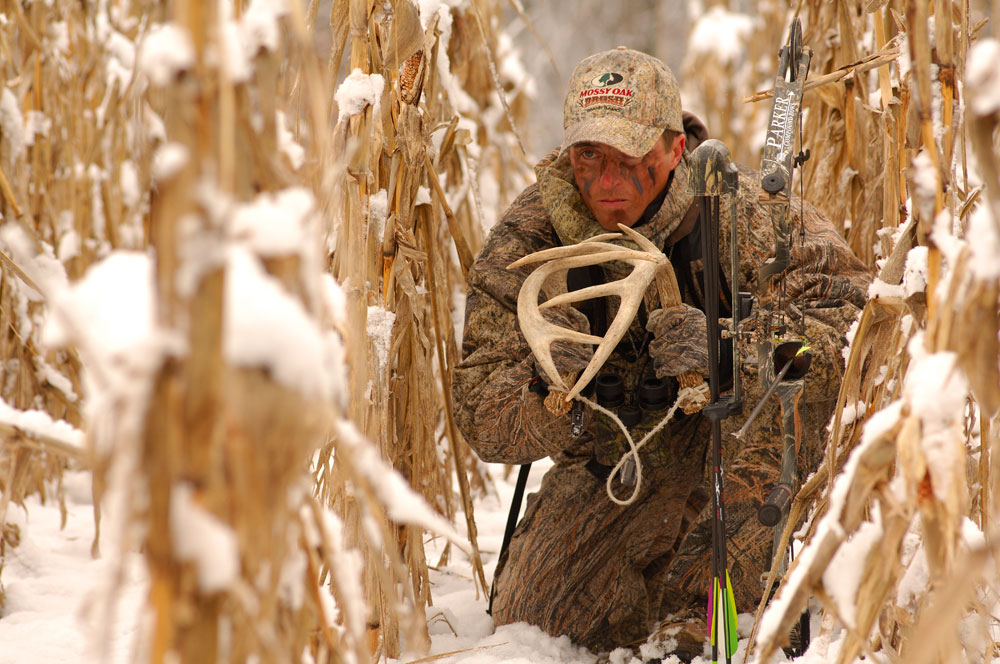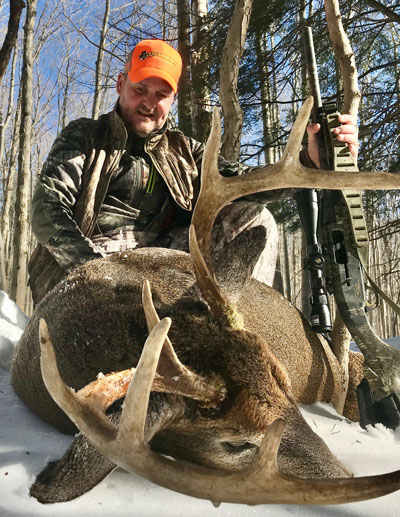provided by John Phillips
Chris Kirby, the president of Quaker Boy Calls, and his wife, Michelle, are now the owners of Quaker Boy Calls in Springville, New York. Here at Mossy Oak, we’ve seen Chris grow up working with his dad, Dick Kirby, the creator of Quaker Boy Calls. Following in Dick’s footsteps, Chris became a major national and world’s champion turkey-calling champion and also is involved in the Quaker Boy videos and television shows. He’s been calling game and taking game since he could walk. As Chris Kirby says, ‘I’ve been a Mossy Oak Pro as long as I can remember. Under our ownership, Quaker Boy will continue to produce its award-winning, quality calls in the USA.” Chris hunts all over the nation for not only deer and turkey with his bow and guns, but about every other type of game that can be called or decoyed into the hunter.

I don’t rattle during the post-rut. If you think about the chasing, the fighting and the staying on their feet during both daylight and nighttime hours that bucks do, by the time a buck reaches the post-rut, he’s tired, beat-up and doesn’t want to fight. The difference in the two bucks I mentioned earlier that Michelle took was the 3-1/2-year-old that weighed 185 pounds before the rut began and the 3-1/2-year-old buck from the same neighborhood that weighed 135 pounds in the post-rut, we assume meant that a buck could lose as much as 30 pounds of weight in 30 days. So, the last thing he’s going to be thinking about in the post-rut is getting in a fight with anybody. As a matter of fact, if he hears rattling, he probably doesn’t even want to see a buck fight.
We butchered three other bucks during the post-rut and none of those bucks had any fat on them. So, when you think about using a deer call, you have to decide why a deer might come or not come to that call. I just hadn’t had any success using rattling antlers to call in bucks in the post-rut.
 We hunt the Ford Ranch in Texas where the deer herd is between one buck for one doe or one buck for two does. Any time you rattle, you may rattle up four or five bucks - even in the post-rut. However, in New York State where I live and hunt, you may spend a lifetime of rattling and never have one buck come in to rattling antlers. The buck-to-doe ratio of the deer herd you’re hunting has a powerful influence on how well any type of deer call will work or won’t work.
We hunt the Ford Ranch in Texas where the deer herd is between one buck for one doe or one buck for two does. Any time you rattle, you may rattle up four or five bucks - even in the post-rut. However, in New York State where I live and hunt, you may spend a lifetime of rattling and never have one buck come in to rattling antlers. The buck-to-doe ratio of the deer herd you’re hunting has a powerful influence on how well any type of deer call will work or won’t work.
One of the newer sounds that has the deer hunters excited is the buck roar. I’ve been hunting deer all of my life, all over the U. S., and I’ve only had two instances when I’ve heard a buck actually roar. The first time I saw a buck give a roar was in the early season when this buck was feeding in a radish field, another buck got close to him, and the buck that was feeding looked up and roared at the other buck. The second buck backed off and went back into the woods. The mature buck kept feeding in the radish field. The second time I heard a buck roar, was when we were hunting in Texas and we rattled in a mature buck. Another buck came from another direction. When he got too close to the first buck, the first buck roared, and the second buck ran away.
But I’ve never seen a grunt call, like the Brawler, cause a buck to leave a place. So, I’ll always have a grunt call with me, but I’ll rarely have rattling antlers with me during the post season. One of the things that I’ve learned that I think may help our readers, is that there is a time when you have to hunt aggressively. I know where there are several bucks on the farms that I hunt, and I hunt the fringe areas around these buck’s core regions. I know the bucks holding in these spots are mature bucks. So, I don’t want to go there and spook them out of their core areas. However, my philosophy has changed somewhat after I had one of my neighbors kill all three of these mature bucks. Once the rut kicked in, those three mature bucks chased an estrous doe out of their core area and onto my neighbor’s property. Now, during the end of October and the first of November each year, I’ve decided that just before the rut kicks in, I’ll find a way to hunt those core areas before the bucks start chasing the does.
I may set up a stand 15 to 20 yards from where that buck will lay down. If that’s where I think I can harvest that buck, I’ll figure out a way to get that close and shoot that mature buck with my bow, rather than allowing one of the does to carry him off to my neighbor’s property.



























